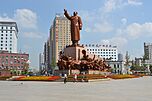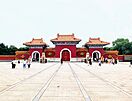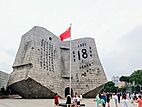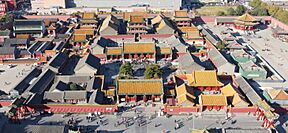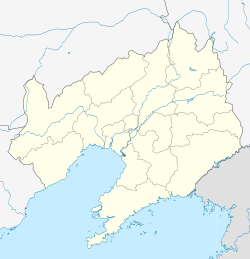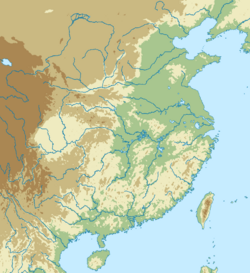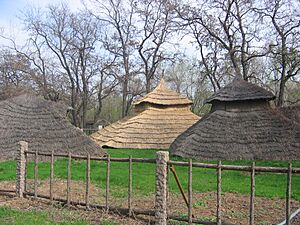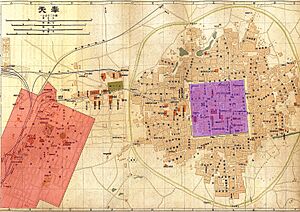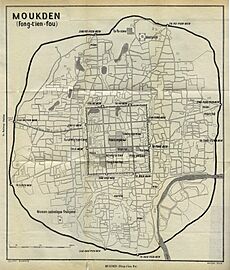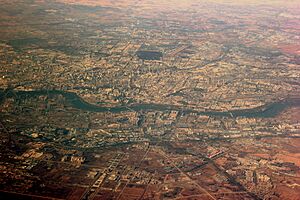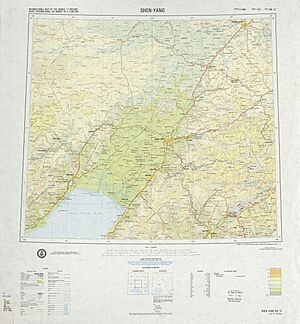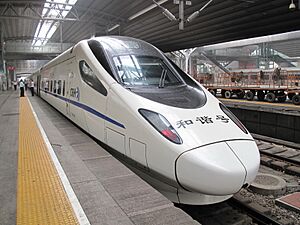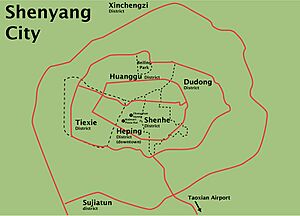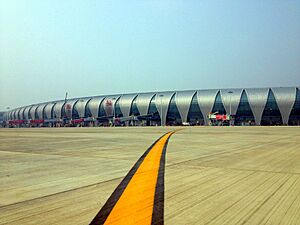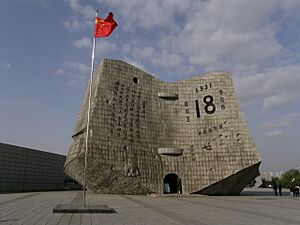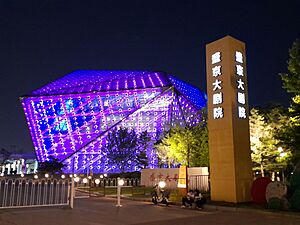Shenyang facts for kids
Quick facts for kids
Shenyang
沈阳市
|
|||||||||||
|---|---|---|---|---|---|---|---|---|---|---|---|
|
Prefecture-level and sub-provincial city
|
|||||||||||
|
Shenyang Skyline
Zhongshan Square
Zhao Mausoleum
Dazheng Hall of Mukden Palace
Mukden Incident Museum
Aerial view of Mukden Palace
|
|||||||||||
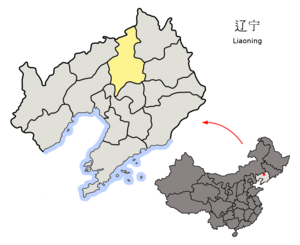
Location of Shenyang within Liaoning
|
|||||||||||
| Country | China | ||||||||||
| Province | Liaoning | ||||||||||
| Municipal seat | Hunnan District | ||||||||||
| County-level divisions | 13 | ||||||||||
| Government | |||||||||||
| • Type | Sub-provincial city | ||||||||||
| • Body | Shenyang Municipal People's Congress | ||||||||||
| Area | |||||||||||
| • Prefecture-level and sub-provincial city | 12,869 km2 (4,969 sq mi) | ||||||||||
| • Urban | 3,658.2 km2 (1,412.4 sq mi) | ||||||||||
| • Metro | 4,222.2 km2 (1,630.2 sq mi) | ||||||||||
| Elevation | 55 m (180 ft) | ||||||||||
| Population
(2020)
|
|||||||||||
| • Prefecture-level and sub-provincial city | 9,070,093 | ||||||||||
| • Density | 704.802/km2 (1,825.43/sq mi) | ||||||||||
| • Urban | 7,885,142 | ||||||||||
| • Urban density | 2,155.470/km2 (5,582.64/sq mi) | ||||||||||
| • Metro | 8,192,848 | ||||||||||
| • Metro density | 1,940.422/km2 (5,025.67/sq mi) | ||||||||||
| GDP | |||||||||||
| • Prefecture-level and sub-provincial city |
|
||||||||||
| • Per capita |
|
||||||||||
| Time zone | UTC+8 (China Standard) | ||||||||||
| Postal code |
110000
|
||||||||||
| Area code(s) | 24 | ||||||||||
| ISO 3166 code | CN-LN-01 | ||||||||||
| License plate prefixes | 辽A | ||||||||||
| Climate | Dwa | ||||||||||
|
|||||||||||
| Shenyang | |||||||||||||||||||||||||||||
|---|---|---|---|---|---|---|---|---|---|---|---|---|---|---|---|---|---|---|---|---|---|---|---|---|---|---|---|---|---|

"Shenyang" in simplified (top) and traditional (bottom) Chinese characters
|
|||||||||||||||||||||||||||||

"Mukden" in Manchu script
|
|||||||||||||||||||||||||||||
| Chinese name | |||||||||||||||||||||||||||||
| Simplified Chinese | 沈阳 | ||||||||||||||||||||||||||||
| Traditional Chinese | 瀋陽 | ||||||||||||||||||||||||||||
| Literal meaning | north bank of the Shen River | ||||||||||||||||||||||||||||
|
|||||||||||||||||||||||||||||
| Mukden | |||||||||||||||||||||||||||||
| Chinese | 盛京 | ||||||||||||||||||||||||||||
| Hanyu Pinyin | Shèngjīng | ||||||||||||||||||||||||||||
| Postal | Mukden | ||||||||||||||||||||||||||||
| Literal meaning | Prosperous [capital] | ||||||||||||||||||||||||||||
|
|||||||||||||||||||||||||||||
| Manchu name | |||||||||||||||||||||||||||||
| Manchu script | ᠰᡳᠮᡳᠶᠠᠨ ᠮᡠᡴᡩᡝᠨ |
||||||||||||||||||||||||||||
| Romanization | simiyan/mukden | ||||||||||||||||||||||||||||
Shenyang is a very important city in China. It is the capital of Liaoning province and the biggest city in Northeast China by the number of people living in its urban areas. In 2020, over 9 million people lived in Shenyang. It's also a major center for transportation and business in the region.
Shenyang has a long and interesting history. It has been ruled by many different groups over time. In the 14th century, the Ming dynasty used it as a strong military base. Later, it became the capital of the Later Jin dynasty, which was the start of the Qing dynasty. The city also saw important battles, like the Battle of Mukden in 1905 during the Russo-Japanese War. In 1931, the Mukden incident led to Japan taking over the area. After World War II, Shenyang was a key city during the Chinese Civil War.
Today, Shenyang is a big industrial city. It's known for making heavy machinery, cars, and electronics. The city is also a hub for science and education. Many important universities, like Northeastern University and Liaoning University, are located here.
Contents
What's in a Name?
The name Shenyang means "the sunny side of the Shen River." This name comes from the Hun River, which used to be called the Shen River. In Chinese tradition, the north side of a river or the south side of a mountain is considered the "sunny" or "yang" side.
A Look Back in Time
Ancient Beginnings
People have lived in the Shenyang area for a very long time, even 8,000 years ago! You can see remains from the Xinle culture, which was a society from the late neolithic period (Stone Age), at a museum in Huanggu District. This culture is about 6,800 to 7,200 years old.
The city we know as Shenyang was first built around 300 BCE during the Warring States period. It was called Hou City back then. Over the centuries, it was controlled by different groups and empires, like the Han dynasty, Goguryeo, and Sui dynasty.
The Manchu Era
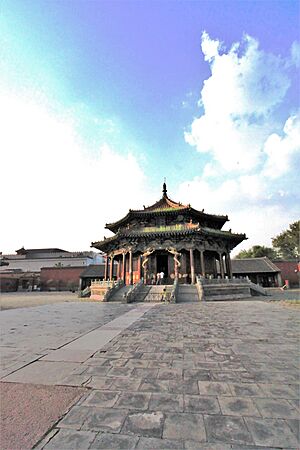
In 1625, a leader named Nurhaci captured Shenyang. He decided to make it the capital of his Jurchen Later Jin dynasty. The city's name was changed to Mukden or Shengjing in 1634. This new name means "to rise" or "prosperous capital."
Nurhaci ordered the building of the Mukden Palace in 1626. This palace showed how powerful the Jurchen people were. It had over 300 fancy rooms and 20 gardens! When the Qing dynasty took over all of China in 1644, they moved the capital to Beijing. But Shenyang remained very important as a second capital and a spiritual home for the Qing rulers.
Russian and Japanese Influence
After a war between China and Japan in the late 1800s, Japan tried to take over the Liaodong Peninsula. But other countries stopped them. Then, Russia gained influence in the area and built railways through Manchuria, including Shenyang.
During the Russo-Japanese War (1904–1905), a huge battle called the Battle of Mukden happened near the city. Over 600,000 soldiers fought in it. Japan won, which increased their power in Shenyang. In 1931, the Mukden Incident happened, where Japanese troops used an explosion as an excuse to invade and take over Northeast China. They created a puppet state called Manchukuo. During this time, Shenyang became a major industrial center for Japan.
After World War II
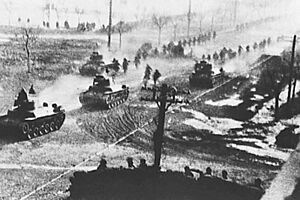
After Japan surrendered in 1945, Soviet troops occupied Shenyang. Later, Chinese forces took control. During the Chinese Civil War, Shenyang was a key stronghold. It was finally captured by the People's Liberation Army in 1948.
Over the last 200 years, Shenyang has grown a lot, especially in industry. It became a main battleground during China's civil war.
Shenyang in the 21st Century
In recent years, Shenyang has been changing. Many old, polluting factories have closed down. The city is now focusing on new industries like software, cars, and electronics. It's also becoming greener, with efforts to reduce pollution.
Exploring the Old City
The old city of Shenyang was located within what is now Shenhe District. It used to have two city walls. The inner wall was first built around 926 CE and later reinforced with bricks in 1388. It had four main gates.
This inner wall was damaged in 1625 when the Manchu army captured the city. But the Manchu leader Nurhaci saw how important the city was and rebuilt the wall. The new wall was taller and stronger, with eight gates.
An outer wall, called the "peripheral wall," was built in 1680 to make the city area bigger. It was almost round and also had eight gates. Most of these old city walls and gates were taken down after 1949. However, some parts have been rebuilt in the 1990s.
Around 2.5 kilometers outside the old outer wall, there were four pagodas, each with a Tibetan Buddhist temple. These were built in 1643. Today, only the North Pagoda's temple is well preserved.
Shenyang's Location and Environment
Shenyang is located in the central part of Liaoning province. The western parts of the city are flat plains near the Liao River. The eastern part has forests and hills from the Changbai Mountains. The city's main urban area is north of the Hun River, which is often called the city's "mother river."
Shenyang has many beautiful parks. The most famous are the South Canal Linear Parks. These parks stretch for 14.5 kilometers along the South Canal. They have many different plants and green spaces, making the city very green. Shenyang was even named a "national forest city" in 2005.
Shenyang's Climate
Shenyang has a climate with four clear seasons. Summers are hot and humid due to monsoons. Winters are dry and very cold because of winds from Siberia. The average temperature for the year is about 8.6 degrees Celsius (47.5°F). Most of the rain falls in July and August.
| Weather chart for Shenyang | |||||||||||||||||||||||||||||||||||||||||||||||
|---|---|---|---|---|---|---|---|---|---|---|---|---|---|---|---|---|---|---|---|---|---|---|---|---|---|---|---|---|---|---|---|---|---|---|---|---|---|---|---|---|---|---|---|---|---|---|---|
| J | F | M | A | M | J | J | A | S | O | N | D | ||||||||||||||||||||||||||||||||||||
|
6
-5
-17
|
9.7
0
-13
|
17
8
-4
|
35
17
4
|
64
24
12
|
93
28
17
|
167
30
21
|
167
29
19
|
51
24
12
|
44
16
4
|
23
6
-5
|
12
-3
-14
|
||||||||||||||||||||||||||||||||||||
| temperatures in °C precipitation totals in mm source: CMA |
|||||||||||||||||||||||||||||||||||||||||||||||
|
Imperial conversion
|
|||||||||||||||||||||||||||||||||||||||||||||||
| Climate data for Shenyang (1991–2020 normals, extremes 1905–present) | |||||||||||||
|---|---|---|---|---|---|---|---|---|---|---|---|---|---|
| Month | Jan | Feb | Mar | Apr | May | Jun | Jul | Aug | Sep | Oct | Nov | Dec | Year |
| Record high °C (°F) | 8.6 (47.5) |
17.2 (63.0) |
22.6 (72.7) |
30.0 (86.0) |
35.7 (96.3) |
39.3 (102.7) |
38.3 (100.9) |
38.4 (101.1) |
32.9 (91.2) |
29.4 (84.9) |
21.7 (71.1) |
13.4 (56.1) |
39.3 (102.7) |
| Mean daily maximum °C (°F) | −4.8 (23.4) |
0.1 (32.2) |
7.5 (45.5) |
17.1 (62.8) |
23.9 (75.0) |
27.6 (81.7) |
29.5 (85.1) |
28.8 (83.8) |
24.4 (75.9) |
16.3 (61.3) |
5.8 (42.4) |
−2.5 (27.5) |
14.5 (58.0) |
| Daily mean °C (°F) | −11.4 (11.5) |
−6.3 (20.7) |
1.7 (35.1) |
10.8 (51.4) |
17.8 (64.0) |
22.3 (72.1) |
24.9 (76.8) |
23.8 (74.8) |
17.9 (64.2) |
9.8 (49.6) |
0.3 (32.5) |
−8.4 (16.9) |
8.6 (47.5) |
| Mean daily minimum °C (°F) | −17.0 (1.4) |
−12.0 (10.4) |
−3.9 (25.0) |
4.3 (39.7) |
11.5 (52.7) |
16.9 (62.4) |
20.6 (69.1) |
19.4 (66.9) |
12.1 (53.8) |
4.0 (39.2) |
−4.7 (23.5) |
−13.5 (7.7) |
3.1 (37.7) |
| Record low °C (°F) | −33.1 (−27.6) |
−28.4 (−19.1) |
−25.0 (−13.0) |
−12.8 (9.0) |
0.2 (32.4) |
3.9 (39.0) |
12.0 (53.6) |
5.7 (42.3) |
−2.6 (27.3) |
−8.3 (17.1) |
−22.8 (−9.0) |
−30.2 (−22.4) |
−33.1 (−27.6) |
| Average precipitation mm (inches) | 6.0 (0.24) |
9.7 (0.38) |
16.7 (0.66) |
35.2 (1.39) |
63.6 (2.50) |
92.5 (3.64) |
167.0 (6.57) |
167.1 (6.58) |
50.8 (2.00) |
44.1 (1.74) |
22.8 (0.90) |
12.0 (0.47) |
687.5 (27.07) |
| Average precipitation days (≥ 0.1 mm) | 3.7 | 3.4 | 4.8 | 6.6 | 9.0 | 11.7 | 12.2 | 10.6 | 6.5 | 7.0 | 5.8 | 4.8 | 86.1 |
| Average snowy days | 4.8 | 4.5 | 4.3 | 1.1 | 0 | 0 | 0 | 0 | 0 | 0.6 | 4.3 | 5.8 | 25.4 |
| Average relative humidity (%) | 63 | 57 | 52 | 49 | 54 | 67 | 77 | 79 | 72 | 66 | 63 | 64 | 64 |
| Mean monthly sunshine hours | 172.4 | 192.0 | 227.3 | 228.7 | 250.3 | 218.4 | 191.8 | 204.3 | 219.9 | 204.8 | 158.5 | 153.0 | 2,421.4 |
| Percent possible sunshine | 58 | 64 | 61 | 57 | 55 | 48 | 42 | 48 | 59 | 60 | 54 | 54 | 55 |
| Source: China Meteorological Administration all-time extreme temperature | |||||||||||||
City Layout and Districts
Shenyang is divided into different areas. The city center has five smaller districts. Around them are four larger suburban districts. There are also four rural areas to the north and west.
Each area has its own focus. The northeast is known for farming. The east is a hub for car parts. The south has high-tech industries. The west is famous for heavy machinery. The city center is where you'll find shops and banks.
Shenyang has 10 city districts, 1 satellite city, and 2 rural counties.
- Shenhe District: This is a central part of downtown. It used to be where the city government was located. The famous Middle Street shopping area is here. You can also find the Mukden Palace and the Wu'ai Market, a huge wholesale center.
- Heping District: Also in downtown, this is the most developed district. It's known for its bright Taiyuan Street shopping area. Northeastern University is here. Zhongshan Square has a very large statue of Chairman Mao.
- Dadong District: This is an industrial area in the east. It has tourist spots like the 9.18 Historical Museum and the North and East Pagodas.
- Huanggu District: This district is home to Beiling park, which has the tomb of the second Qing emperor, Huang Taiji.
- Tiexi District: This is the most populated district in the west. It's famous for its heavy industry. It also has many homes and shopping areas. A documentary film called West of the Tracks shows how this area changed.
- Hunnan District: Located in the east and southeast, this district is south of the Hun River. It's home to the Shenyang Taoxian International Airport and is becoming a modern area with luxury homes and businesses. The city government moved here in 2015.
- Sujiatun District: This is the southernmost suburban area. It's known for farming and industry.
- Shenbei New District: This is a new development zone in the northern suburbs. It's a large area with growing industries.
- Yuhong District: This district is in the northwest and west suburbs. It has a mix of residential and business areas.
- Liaozhong District: This is the newest and largest suburban district, located southwest of downtown Shenyang. It used to be a rural county but became a city district in 2016.
Getting Around Shenyang
Shenyang is a major transportation center in Northeast China. You can travel by air, train, subway, and bus.
Train Travel
Shenyang is a main railway hub for Northeast China. Many railways connect Shenyang to big cities like Beijing, Dalian, and Harbin. High-speed trains make travel much faster. For example, you can get to Beijing in about 4 hours.
Shenyang has two main train stations:
- Shenyang North Railway Station: This is a very important railway hub in China. It has been expanded to handle many passengers and high-speed trains. It even has an underground city with shops and parking.
- Shenyang Railway Station: This station is over 100 years old. It was built by the Russians and later expanded by the Japanese. Today, it mostly handles regular-speed trains and is being updated.
Roads and Highways
Shenyang's streets are mostly laid out in a grid pattern. Roads running north-south are usually called "streets" or "avenues." Roads running east-west are called "roads" or "boulevards."
The city also has several ring roads that go around the city. The 3rd Ring Road is an 82-kilometer freeway. The 4th Ring Road is a 132-kilometer highway. There are also plans for a 5th and 6th Ring Road.
Several major highways connect Shenyang to other regions. The Shenyang–Dalian Expressway is China's first expressway. It connects Shenyang to Dalian, a large port city. Other expressways lead to cities like Benxi, Dandong, and Jilin. The Beijing–Shenyang Expressway connects Shenyang to the capital city, Beijing.
Airport Access
The city is served by the Shenyang Taoxian International Airport. It's one of the busiest airports in China. There are other airports in Shenyang, but they are not open to the public.
Public Transportation
Shenyang has over 160 bus routes. The city also has a modern tram network that started in 2013, mainly in the Hunnan New District.
The Shenyang Metro is the city's underground train system. The first line opened in 2010, and the second line opened in 2012. As of 2023, there are 5 subway lines, making it easier to travel across the city.
Culture and Fun in Shenyang
Language and Arts
People in Shenyang speak the Shenyang dialect, which is a type of Northeastern Mandarin. It's similar to standard Mandarin but has its own unique words.
Two popular folk dances, Errenzhuan and Yangge, are very popular here. Shenyang is also known for its Chinese comedy. Many famous comedians come from this city.
Museums to Explore
- Liaoning Provincial Museum: This is the biggest museum in Northeast China. It has many ancient items and writings.
- Shenyang Steam Locomotive Museum: Here you can see 16 old steam engines from different countries.
- 9.18 Historical Museum: This museum remembers the Mukden Incident of September 18, 1931. It's built in the shape of an open calendar.
- Xinle Relic: This site shows where the ancient Xinle culture lived. It has a rebuilt village and artifacts.
Sports and Recreation
Shenyang loves football! The local team, Liaoning F.C., was once a national champion for 10 years in a row. The Shenyang Olympic Sports Center Stadium was even used for football games during the 2008 Summer Olympics.
The city also has a large speed skating rink.
Places of Worship
Shenyang recognizes five main religions: Buddhism, Taoism, Islam, and Christianity (Catholicism and Protestantism). There are many temples, mosques, and churches in the city.
Some famous religious sites include:
- Chang'an Temple: A Zen Buddhism temple built during the Tang dynasty.
- The Four Pagodas of Early Qing: These are four white Tibetan Buddhist pagodas built in 1639.
- Taiqing Palace: A Taoism temple built in 1663.
- Sacred Heart Cathedral of Shenyang: A Roman Catholic cathedral.
- Dongguan Church: One of the largest and oldest Protestant churches in Northeast China.
- South Mosque: The largest mosque in Northeast China.
Delicious Food
Shenyang has classic northeastern Chinese cuisine. Popular dishes include suan cai (Chinese sauerkraut) and stewed chicken with mushrooms. Because many Korean people live here, you can also find delicious Korean food like rice cake and cold noodles. The food is also influenced by traditional Manchu dishes.
You can also find halal foods, which are popular with both Muslim and non-Muslim people.
Top Attractions for Visitors
- Mukden Palace: This was the old imperial palace of the early Qing dynasty. It's a UNESCO World Heritage Site.
- East Mausoleum: The tomb of the first Qing emperor, Nurhaci. It's also a UNESCO World Heritage Site.
- Beiling Park and North Mausoleum: This park has the tomb of the second Qing emperor, Huang Taiji. It's a very large park and a UNESCO World Heritage Site.
- Qipan Mountain: A fun resort area northeast of Shenyang.
- Strange Slope: A mysterious slope where cars seem to roll uphill by themselves!
- Shenyang Botanical Garden: This huge garden hosted the International Horticultural Exposition in 2006. It's now called the Shenyang International Expo Garden.
- Meteorite Mountain Forest Park: This park has the oldest and largest meteorite in the world.
Shopping in Shenyang
Shenyang has many great places to shop!
- Middle Street: This shopping street is over 100 years old. It's one of China's most famous shopping streets and was the first pedestrian-only shopping street in the country.
- Taiyuan Street: Another popular shopping area with many stores, restaurants, and theaters. It also has a large underground shopping center.
- Wu'ai Market: A huge multi-story shopping center known for selling cheap clothes and household items.
- Sanhao Street: This area is the center for information technology products.
Learning and Research
Shenyang is a major city for science and education in Northeast China. It has many colleges, universities, and research centers.
Important Universities
- China Medical University
- Liaoning University
- Northeastern University
- Shenyang Agricultural University
- Shenyang Aerospace University
- Shenyang Conservatory of Music
- Shenyang Pharmaceutical University
- Shenyang University
International Connections
Shenyang has good relationships with many cities around the world. It has sister city agreements to promote business, culture, and education.
Sister Cities
 Sapporo, Japan 1980
Sapporo, Japan 1980 Kawasaki, Japan 1981
Kawasaki, Japan 1981 Turin, Italy 1985
Turin, Italy 1985 Chicago, United States 1985
Chicago, United States 1985 Irkutsk, Russia 1992
Irkutsk, Russia 1992 Quezon City, Philippines 1993
Quezon City, Philippines 1993 Ramat Gan, Israel 1993
Ramat Gan, Israel 1993 Gongju, South Korea 1996
Gongju, South Korea 1996 Chuncheon, South Korea 1998
Chuncheon, South Korea 1998 Seongnam, South Korea 1998
Seongnam, South Korea 1998 Yaoundé, Cameroon 1998
Yaoundé, Cameroon 1998 Ho Chi Minh City, Vietnam 1999
Ho Chi Minh City, Vietnam 1999 Gumi, South Korea 1999
Gumi, South Korea 1999 Thessaloniki, Greece 2000
Thessaloniki, Greece 2000 Ostrava, Czech Republic 2006
Ostrava, Czech Republic 2006 Katowice, Poland 2007
Katowice, Poland 2007 Hamamatsu, Japan 2010
Hamamatsu, Japan 2010 Ufa, Russia 2011
Ufa, Russia 2011 Novosibirsk, Russia 2013
Novosibirsk, Russia 2013 Incheon, South Korea 2014
Incheon, South Korea 2014 La Plata, Argentina 2014
La Plata, Argentina 2014 Belfast, Northern Ireland 2016
Belfast, Northern Ireland 2016
Friendship Cities
 Pittsburg, California, United States
Pittsburg, California, United States Düsseldorf, Germany
Düsseldorf, Germany Marabá, Pará, Brazil
Marabá, Pará, Brazil
Images for kids
-
Xita, the world's 2nd largest Koreatown
See also
 In Spanish: Shenyang para niños
In Spanish: Shenyang para niños



